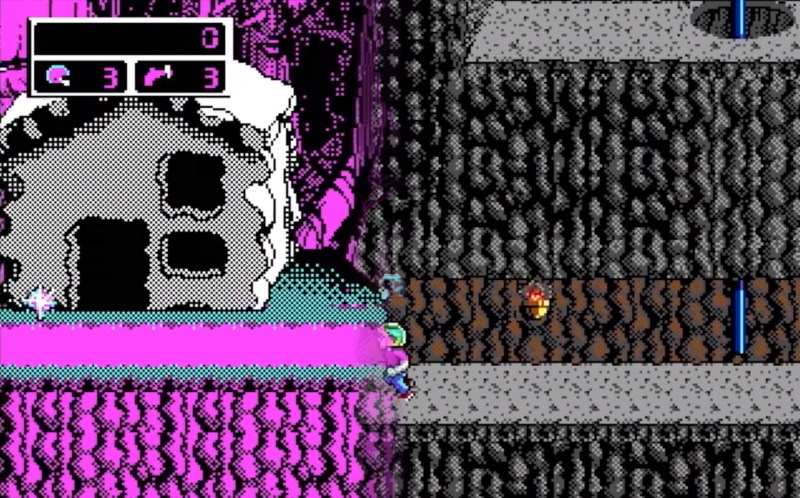We have to admit, we expected to be bored through [The 8-Bit Guy]’s presentation, only to stay riveted through his comparison of early graphic card technology.
Some presentations get a bit technical, which isn’t bad, but what is so interesting about this one is the clear explanation of what the market was like, and what it was like for the user during this time. For example, one bit we found really interesting was the mention of later games not supporting some of the neat color hacks for CGA because they couldn’t emulate it fully on the VGA cards they were developing on. Likewise, It was interesting to see why a standard like RGBI even existed in the first place with his comparison of text in composite, and much clearer text in RGBI.
We learned a lot, and some mysteries about the bizarre color choices in old games make a lot more sense now. Video after the break.
















The hack of course being the strange things developers did to pull off colors that the CGA cards technically weren’t capable of producing. I’ve heard of this before, but this guy does a good job of spelling it all out for the layman. I love playing with old machines just to see what unusual performance I can squeeze out of them. It seems simple, but I like seeing old machines display pictures and video as close to 100% accurate as they can get.
I would add two more videos by 8-Bit Guy related to graphics:
https://www.youtube.com/watch?v=Tfh0ytz8S0k
https://www.youtube.com/watch?v=_rsycfDliZU
Also Lazy Game Reviews has lots of interesting videos on obsolete computers: https://www.youtube.com/user/phreakindee/videos
I never knew about the color modes used with the composite out of what he calls *true* CGA cards because it was NTSC so there were no monitors for it in my country.
What perhaps he didn’t mention is that the bit patterns produced different colors because the dot clock was a higher frequency or around the frequency of the color sub-carrier (color burst) so different bit patterns were interpreted by the TV as different phases and colors are represented by phase.
The old hardware that was designed for arcade machines had a few tricks as well.
I used to watch him when he was The iBook Guy. I guess he decided to embrace the obsolescence and go full retro. I still use a 2005 iBook for pretty much everything, but his newer videos really go back to my childhood as a DOS geek.
I loved my CGA monitor for the fact that I was also playing with flea-market video cameras at the time and could switch between my 7Mhz Turbo XT and the composite camera output just like he was doing in the video with his, saving money and space in the attic where I lived.
I also was running a monochrome video card next to the CGA in a dual monitor setup, although the mono monitor was used mostly for pasting land line BBS phone numbers onto for the modem-based geeky madness that was common in its day.
All this on a desk made from the door of an old house supported by plastic milk crates and an old lab stool.
My first modem (external 1220 baud) was nailed to a board because my brother needed the case for a project.
I also recall installing an external speaker jack and volume control and running an old stereo speaker for that awesome booming 1-bit PC sound.
Good times.
Good. freaking. times.
Make that modem a 1200 baud, sorry.
Oh man, yes! Running multi-head with the old graphics cards was possible because they occupied different address ranges. I had VGA + CGA on my DesQView box for quite a while, and it was great for a few layouts:
For music and BBSing: Telemate on the VGA side (sharper text), Galaxy 2.12 and a DOS prompt on the CGA side.
For BBSing and pictures: DOS prompt for loading CShow on the VGA side, Telemate in 40-column mode on the CGA side.
For music and other crap: Cubic Player in graphics mode on the VGA side, DOS prompt and whatever else on the CGA.
Moving windows back and forth was nearly impossible; it basically meant closing the program and relaunching it with a commandline switch to address the other video mode. Still, basically nobody was doing dual monitors at the time, and it felt amazing despite its limitations. I still have that CGA board downstairs, maybe I should try to fire up a similar rig and make some videos.
Lol strider, i like you, jury rigged many things, like a 56k modem hard wired into the house alarm system… my dad was so pissed off when he saw that :)
Ahhh the good ol days of war dialing!
What really sucked when I was a kid living in Australia was that the artifacting tricks that our TRS-80 used didn’t translate to PAL, so a lot of stuff looked shit with weird coloured bars etc.. It wasn’t until comparatively recently I figured out that people in NTSC markets would have seen a markedly different picture.